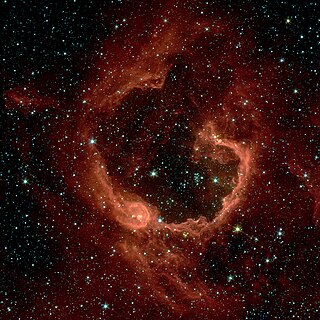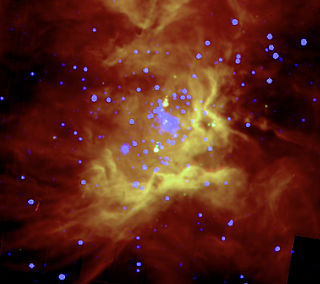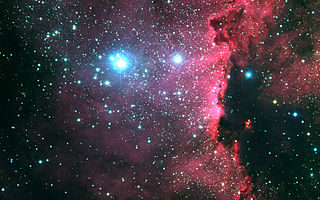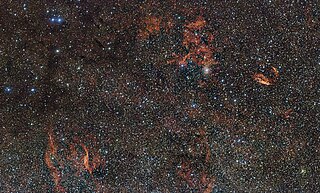The Damon Knight Memorial Grand Master Award is a lifetime honor presented annually by the Science Fiction and Fantasy Writers Association (SFWA) to a living writer of fantasy or science fiction. It was first awarded in 1975, to Robert Heinlein. In 2002, it was renamed after Damon Knight, the founder of SFWA, who had died that year.

The Lagoon Nebula is a giant interstellar cloud in the constellation Sagittarius. It is classified as an emission nebula and has an H II region.
Gun laws in the United States regulate the sale, possession, and use of firearms and ammunition. State laws vary considerably, and are independent of existing federal firearms laws, although they are sometimes broader or more limited in scope than the federal laws.

IC 2944, also known as the Running Chicken Nebula, the Lambda Centauri Nebula or the λ Centauri Nebula, is an open cluster with an associated emission nebula found in the constellation Centaurus, near the star λ Centauri. It features Bok globules, which are frequently a site of active star formation. However, no evidence for star formation has been found in any of the globules in IC 2944. Other designations for IC 2944 include RCW 62, G40 and G42.
The RCW Catalogue is an astronomical catalogue of Hα-emission regions in the southern Milky Way, described in. It contains 182 objects, including many of the earlier Gum catalogue objects.
The Washington State Department of Information Services (DIS) was a Governor's Cabinet-level agency that provided information technology assistance to state and local agencies, school districts, tribal organizations, and qualifying nonprofit groups in Washington.

The Gum catalog is an astronomical catalog of 84 emission nebulae in the southern sky. It was made by the Australian astronomer Colin Stanley Gum (1924-1960) at Mount Stromlo Observatory using wide field photography. Gum published his findings in 1955 in a study entitled A study of diffuse southern H-alpha nebulae which presented a catalog of 84 nebulae or nebular complexes. Similar catalogs include the Sharpless catalog and the RCW catalog, and many of the Gum objects are repeated in these other catalogs. However, the RCW and Gum catalogs were mainly of the southern hemisphere

RCW 120 is an emission nebula and H II region in the southern Milky Way and located some 4,300 light-years from Earth.

RCW 38 is an HII region containing a massive star cluster located approximately 5,500 light years away from Earth in the direction of the constellation Vela. The stars were very recently formed, and are still enshrouded within the dark cloud in which they were born. The star cluster is surrounded by clouds of brightly glowing gas and is composed of several short-lived massive stars, hundreds of young stars, and many protostars.

RCW 49, also known as NGC 3247, is a H II region nebula located 13,700 light years away. Other designations for the RCW 49 region include NGC 3247 and G29 and it is commonly known as the Whirling Dervish Nebula. It is a dusty stellar nursery that contains more than 2,200 stars and is about 300-400 light years across. RCW 49 is recognized as among the brightest and most massive HII regions.

RCW 88 is an emission nebula in the southern constellation of Circinus that first appeared in the 1960 astronomical catalogue by Rodgers, Campbell & Whiteoak (RCW) of Hα-emission regions within the southern Milky Way. Earlier observers, like James Wray in 1966, misclassified this as a likely 12.0v magnitude planetary nebula, but later spectroscopic investigations revealed this as a diffuse nebulae. RCW 88 was then to be identified by the infrared satellite IRAS as an HII region.

RCW 79 is an emission nebula in the constellation Centaurus.

RCW 36 is an emission nebula containing an open cluster in the constellation Vela. This H II region is part of a larger-scale star-forming complex known as the Vela Molecular Ridge (VMR), a collection of molecular clouds in the Milky Way that contain multiple sites of ongoing star-formation activity. The VMR is made up of several distinct clouds, and RCW 36 is embedded in the VMR Cloud C.

Riot City Wrestling (RCW) is an Australian independent professional wrestling promotion founded in January 2006 in Adelaide, South Australia. It runs shows independently, in conjunction with local festivals, as well as with other organizations and wrestling promotions.

Sh 2-308, also designated as Sharpless 308, RCW 11, or LBN 1052, and commonly known as the Dolphin-Head Nebula, is an H II region located near the center of the constellation Canis Major, composed of ionised hydrogen. It is about 8 degrees south of Sirius, the brightest star in the night sky. The nebula is bubble-like and surrounds a Wolf–Rayet star named EZ Canis Majoris. This star is in the brief, pre-supernova phase of its stellar evolution. The nebula is about 4,530 light-years away from Earth, but some sources indicate that both the star and the nebula are up to 5,870 ly (1,800 pc) away. Yet others indicate the nebula is as close as 1,875 ly (575 pc) from Earth.

RCW 34 - H II region and the emission nebula located in the constellation Vela. It is located approximately 22,000 light years from Earth. Named after Australian astronomer Colin Stanley Gum.

Sh 2-10, also called RCW 130, is an emission nebula in the Scorpius constellation.

RCW 108, also called the Rim Nebula, is a large star formation in the Milky Way, about 4,000 light years from Earth. RCW 108 is part of the Constellation Ara. is in the process of being destroyed by intense light which radiates from a star inside of NGC 6193. NGC 6188 has an angular extent of 20.0' × 12.0', and has been heavily documented by multiple telescopes, including Chandra and Spitzer.

RCW 106 is a large star-forming nebula in the Constellation Norma. RCW 106 is visible in the direction of the R103 OB association and is embedded in a 100 thousand solar mass 28 pc x 94 pc giant molecular cloud. The RCW catalogue designates the two brightest regions of this nebula as RCW 106a and RCW 106b but these do not appear to be distinct objects.















